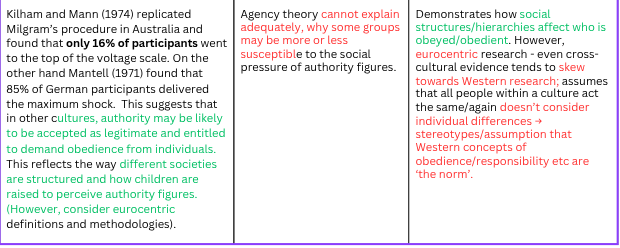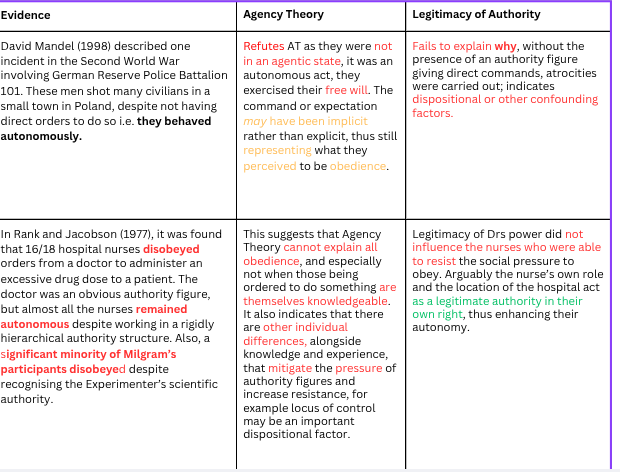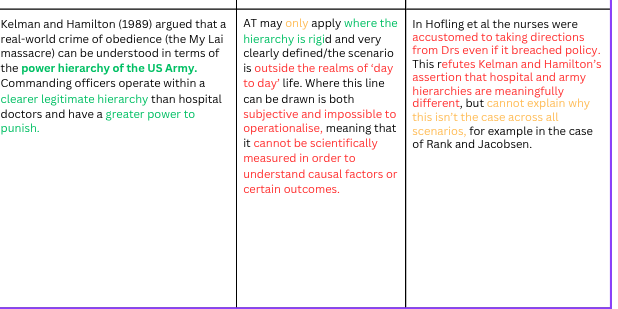Agency theory, Legitimacy of Authority
1/20
There's no tags or description
Looks like no tags are added yet.
Name | Mastery | Learn | Test | Matching | Spaced |
|---|
No study sessions yet.
21 Terms
What is the agentic state?
Mental state- we feel no personal responsibility for our behaviour, we believe ourselves to be acting for an authority figure, i.e as their agent- frees us from demands of our consciences, allows obedience even to a destructive authority figure
What did Milgram propose about destructive authority and the agentic state?
Obedience to a destructive authority occurs because a person does not take responsibility- believes that they are acting for someone else, they are an ‘agent’
Agent experiences high anxiety if they come to a realisation that they are doing a wrong thing but feel powerless to disobey- moral strain
What is the autonomous state?
The opposite of being in an agentic state- free to behave according to own principles, feels responsibility for their own actions
What is the agentic shift?
Autonomy —> Agency
Milgram (1974) suggestes bthat this occurs when someone is perceived to be another’s authority figure, so they defer to their legitimate authority as they have greater power
What are binding factors?
Aspects of the situation that allow the person to ignore or minimise the damaging effect of their behaviour, keeping them in the agentic state- reduces ‘moral strain’
Milgram proposed a number of strategies that the individual uses, e.g. shifting blame to victim (‘he was foolish to volunteer’), denying damage they were doing
What is legitimacy of authority?
An explanation for obedience- suggests we are more likely to obey those who we perceive to have authority over us, and that this authority is legitimate/justified by the individual’s position of power within a social hierarchy
What are the consequences of legitimacy of authority?
It is generally accepted that authority figures have the right to exercise more social power as it allows society to function smoothly
Some people are allowed to punish others- we are willing to give up some independence and hand over control to people we trust to appropriately exercise authority e.g to police and courts
Acceptance of legitimate authority learned from childhood- caregivers, teachers, adults
What is destructive authority?
Charismatic and powerful leaders can use legitimate power for destructive purposes, ordering cruel and dangerous behaviour
Evident in Milgram’s study- Experimenter used prods to order participants to act against their consciences
E.g. My Lai massacre
What is the strength of research support in Agentic state?
Milgram’s studies support the role of agentic state in obedience- most participants resisted giving shocks at some point and asked E questions, e.g ‘Who is responsible if L is harmed?’, when E said ‘I’m responsible’, participants quickly carried on
Participants acted more willingly as E’s agent when they perceived they were not responsible for their own behaviour
What is the evaluation of cultural differences in obedience?
Useful explanation- studies show countries differ in degree of obedience to authority
Kilham and Mann (1974)- only 16% of Australian women went up to 450V
Mantell (1971)- 85% for German participants
Some cultures are more likely to accept authority as legitimate and entitled to demand obedience- reflects structural differences of societies and differences in child upbringing in terms of perception of authority figures
Strength- Kelman and Hamilton (1989)- argument that My Lai massacre can be explained by obedience to power hierarchy of army- operate within a clearer legitimate hierarchy than doctors in a hospital, have a greater power to punish
What is a limitation of the agentic shift?
Cannot explain the results of Milgram’s variations
Birney et al. (2024)- extent of varied obedience rates in different situations suggests obedience is a product of the situation, rather than simply a ‘natural inclination to obey’- agentic shift would predict high obedience regardless of situation, but obedience varied from 0 to 100%
All characteristics of the situation need to be taken into consideration, not solely the agentic shift
What limitation was offered by Mandel (1998)?
Limitation of agentic state- Incident in WW2 where German soldiers shot many Polish civilians without having direct orders to do so- behaved autonomously
Can Milgram’s theory explain disobedience all the time?
Cannot explain disobediebce in a hierarchy of clear, accepted LOA- the military, hospitals
Rank and Jacobson (1977)- nurses willing to disobey doctor despite hierarchy of authority, small % of Milgram recognised E’s authority but disobeyed
Some people more/less obedient than others- innate tendency for obedience may have greater influence on behaviour than the legitimacy of an authority figure
How did LOA and AT affect Milgram’s Location Variation?
LOA- In a rundown building, perceived LOA decreased in comparison to prestigious Yale, where there was an expextation that E shared this setting’s LOA
Obedience still quite high due to PP belief in ‘scientific’ nature of experiment, E still had some LOA and T thought they had greater scientific knowledge
AT- change of location caused PP to remain in the autonomous state as there was a decreased belief in E being entitled to expect obedience from T
How did LOA and AT affect Milgram’s Uniform Variation?
LOA- Uniforms ‘encourage’ obedience and are often seen as symbols of LOA- the lack of uniform on the confederate decreased perceived LOA and right to expect obedience
AT- participant more likely to remain in autonomous state and resist agentic shift
How did LOA and AT affect Milgram’s Proximity Variation?
LOA- the closer E to T, the greater the perceived LOA
AT- As proximity to L increased, obedience decreased as T grew more aware of the harm they were causing, moral strain increased thus less able to deny their responsibility- felt less like an ‘agent’, remained in the autonomous state, resisting obedience more
What increases the likelihood of obedience according to LOA and AT?
LOA- appearance of authority figure e.g. wearing a lab coat due to uniforms, chances of punishment due to disobedience, personality of authority figure, cultural influence on perception of LOA, formality of the settings
AT- Removing feeling of responsibility for consequences of actions- if you are in an agentic state you believe you are an ‘agent’, so have no choice but to continue
e.g. E providing vocal ‘prods’ commanding T to continue- felt more as if they have no choice but to continue as they are an agent for E
Blass and Schmidt (2001), Hofling limitation
Kilham and Mann (1974)

Mandel (1998), Rank and Jacobson (1977)

Kelman and Hamilton (1989)
